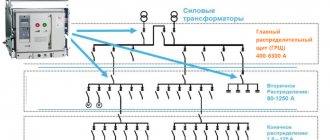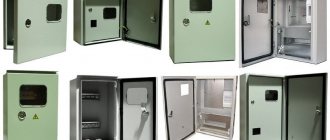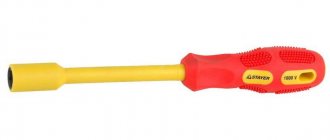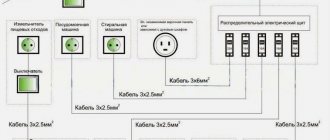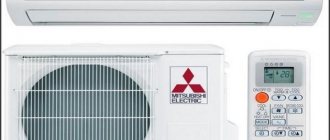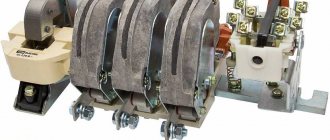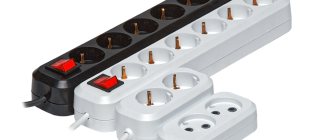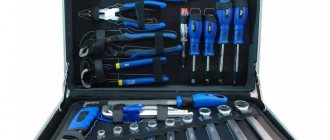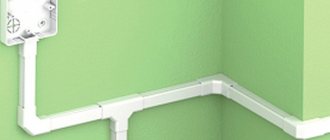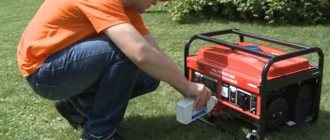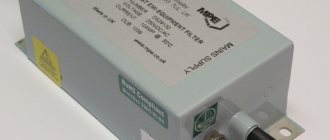It is unacceptable to combine N and PE buses if they are separated in the cable supplying the shield. Each panel must have busbars (clamp assemblies) for connecting neutral conductors: working - N, protective - PE or PEN. The combined conductor of the PEN cable feeding the shield is connected to the PE bus of the switchboard (requirements of paragraphs 1.7.135; 4.1.22 PUE).
The reliability and durability of any electrical panel is largely determined by the way the input terminals of the outgoing cable protection devices are connected to the output terminals of the input protection device. Previously, tires were always used for these purposes, which were very reliable, but took up a lot of space (see Fig. 1). Currently, such buses are used only in switchboards with high-power loads (ASU, main switchboard). And in ordinary distribution boards, specially designed compression blocks and small-sized busbars are used, installed on modular circuit breakers. Using a wiring board for busbar, as shown in Fig. 2 is often less reliable.
Important:
When installing any electrical panel, tools must be used that are appropriate for the task being performed. When tightening screws, you must ensure that the slots of the screwdrivers match the slots of the screws. This is especially true for cross-shaped splines. If you use screwdrivers with ground slots, the transfer of torque and pressure to the screw head may not be sufficient to obtain high-quality contact. A new good power tool, as well as various hand tools, can always be quickly purchased in a wide network of online stores. The official websites of some popular stores are listed in the website article Tool stores.
All protective devices, as well as other components, must be properly secured. Despite this obvious requirement, circuit breakers can be seen hanging on wires (Fig. 3).
Electrical distribution board
Rice. 1 Distribution board
Wiring the panel with wires
Fig.2 Wiring the switchboard
Unacceptable fastening methods
Fig.3 Unacceptable fastening methods
Connecting the electrical panel. Standards and rules for placement
This article provides rules and advice for connecting distribution boards based on the standards of the Republic of Belarus and Russia, and recommendations from the world's leading manufacturers of panel board products.
The electrical panel is the heart of your electrical installation. It is designed to house the devices and equipment needed to distribute all electrical circuits and protect people and property.
Selecting an electrical panel
Parameters for selecting a distribution board:
1. Type of installation. There are internal versions, for hollow or hollow walls (plasterboard) and external versions (attached to any base).
When choosing the type of electrical panel, pay attention to the material and design features of the walls of the room in which it will be installed. For example, in panel houses, it is practically impossible to install a built-in electrical panel of more than 12 modules without causing damage to the load-bearing walls. In such rooms, it is recommended to install panels either externally or internally for hollow walls, with a plasterboard structure.
2. Number of modules . For apartments and cottages, switchboards are used with the ability to install modular devices up to 63A. The number of modules determines the total number of electrical wiring lines and modular devices + a reserve of at least 20% (preferably 30%) is made for the possible connection of additional equipment in the future.
3. Degree of protection. For indoor installation, electrical panels with a degree of protection of IP30-IP40 are used, and for installation in unfavorable conditions (basement, bathhouse, open area), you should choose panels with a degree of protection IP44-IP65.
4. Material. Shields can be made of metal or plastic. In residential premises, it is better to opt for plastic panels, and in utility rooms (garage, workshop, etc.) it is better to use metal ones.
Electrical panels located in residential premises must have lockable doors (preferably metal ones). If there are children, the door must be closed with a locking device that does not allow a child to open it. Locking the apartment panel with a key is not recommended.
Electrical panel placement
For the input device for power supply and telecommunications, in residential premises it is recommended to provide areas in which the installation of an electrical panel, fire alarm and security systems, automation equipment, telecommunication networks (telephone, television, Internet, etc.) is carried out.
Centralizing various devices in one place allows for easier access and maintenance of various components necessary for the normal functioning of electrical equipment and low-current systems located in the same room.
Such zones should be located in the apartment itself or in the house (preferably at the entrance), in the garage or in an additional room (panel room).
Electrical panels can be installed both in specially prepared niches (internal installation) and on various fire-resistant bases (outdoor installation).
The shield is installed at a height ranging from 1 meter (lower edge) to 1.8 meters (upper edge). As an exception, the shield can be installed within 0.5 - 1.3 meters if elderly people or people with disabilities live in the room.
Installation of distribution boards (for an apartment or private house) is prohibited :
- In bathrooms and showers (outside and in hazardous areas 0, 1 and 2);
- In a closet or wardrobe;
- Above heaters;
- Under and above the sink or washbasin;
- Above the hob;
- Installation outside the home (including balcony or loggia)*
- In the toilet;
- On flights of stairs;
- In damp areas;
- In ventilation shafts;
*The distribution board should not be confused with the metering board, which can be installed at the border of a country house plot.
Selecting the cable cross-section for powering the electrical panel
The cross-section of the cable cores supplying the internal distribution board (apartment or house) depends on:
1. Voltage rating (220 or 380 Volts).
The electrical panel of the apartment in most cases is connected to a single-phase voltage of 220-230 Volts. Three-phase input, in apartments in Minsk, is very rare and practically never occurs.
In country houses, the best solution would be to connect to a three-phase voltage - 380-400 Volts.
2. The allocated power and rating of the main feeding machine (installed in a common floor switchboard or in a metering switchboard), as well as the distance between switchboards.
If the distance between the main supply circuit breakers (or circuit breakers) of the switchboards is no more than 30 meters, then the cable cross-section for single-phase power supply of the apartment switchboard can be determined from the table below:
If the distance between the main supply circuit breakers (or switches) of the panels is more than 30 meters, then when choosing the cross-section of the cable cores, it should be additionally determined using the tables (taking into account power and distance).
To quickly select the desired cable cross-section, taking into account the distance, the following table will help:
Which cable to choose?
Transfer input device
If the electrical installation includes a source of autonomous power supply (for example, a diesel generator), then the system must have a reserve input device, which is installed after the electricity meter. We are talking about a switch that allows you to manually connect consumers to a generator or to an external power supply system. This device does not allow simultaneous use of two different power sources (transformer substation and diesel generator). This is its key advantage.
Installation of a mounted electrical panel, fastening the panel, machines, wires
In this article, we will look at the step-by-step installation of a mounted electrical panel on site. Hello Dear Reader! After selecting the location for installation and completing the hanging switchboard, we proceed to its immediate installation. Let's take a step-by-step look at all the stages of installing a hinged panel and start with preparing the tool.
Tool for installing electrical panels
To install the shield you will need the following tool:
- Electric impact drill or hammer drill;
- A set of drills according to the type of wall on which the electrical panel will be installed;
- Building level;
- Yardstick;
- Screwdriver Set;
- Pliers;
- Wire cutters;
- Knife or special tool for stripping wire insulation;
- Tags for marking wires;
- Insulating tape;
- Pencil.
After preparing the tool and the electrical panel housing, you can begin installing it.
Marking the location for installing a wall-mounted electrical panel
The electrical panel should be installed strictly vertically or horizontally, as you prefer. It is better to choose 1.5-1.7 meters for the installation height of the electrical panel for ease of further maintenance.
Before starting work, the electrical panel housing must be disassembled into its component parts.
On the body of the electrical panel there are technological perforated holes for entering electrical cables into the electrical panel. There are usually more of them than needed.
It is necessary to select the proposed places for the cables to enter the shield and break out the technological holes.
Note: A mounted electrical panel can be installed both before and after electrical installation. Depending on the type of electrical wiring, electrical cables are inserted into the panel from above and/or from below, through the side walls, or through the rear wall of the electrical panel.
Steps for installing a wall-mounted electrical panel
1. Measure the installation height of the electrical panel from the floor and draw a horizontal line along the building level;
2. Draw a vertical line along the planned edge of the electrical panel installation;
3. Attach the base of the electrical panel body to the marks made and mark the places for fastening with a pencil. On the base of the case there are special technological holes for attaching the electrical panel. There are two, four or six mounting holes, depending on the size of the electrical panel.
Note: If you are installing an electrical panel on a wall made of plasterboard, then when purchasing a wall-mounted electrical panel, choose a model that can be equipped with special fasteners for installation on a plasterboard wall (see photo).
4.Load the drill bit into the drill and drill holes in the wall to mount the electrical panel;
5.Install the dowels into the drilled holes. Place the base of the electrical panel housing against the wall and screw it to the wall.
Note: Do not forget to insert the electrical wiring cables into the switchboard, which are inserted into the switchboard through the rear wall.
Before final tightening of the mounting screws, accurately set the installation level of the electrical panel. Use a building level for this. Check the installation level of the electrical panel horizontally and vertically, and finally tighten the mounting screws.
The base of the electrical panel housing is installed.
We begin assembling the electrical panel
6. To begin, install DIN rails (3) and terminal blocks (1,2) in the electrical panel.
For their installation, special fastenings are made at the base of the electrical panel. The mounting locations depend on the manufacturer of the electrical panel. Typically, connecting blocks are attached at the top or bottom of the shield.
DIN rails are attached across the shield in the center, in one, two, three or four rows. Accordingly, shields are called single-row, double-row, three-row and four-row.
Left a little.
7. You need to bring all the wires and electrical cables into the electrical panel. First lay out the electrical cables along the electrical panel body on the right and left.
If there are a large number of wires, lay them out under the DIN rails.
SPD
To protect the electrical installation from high-voltage pulses, from the consequences of a direct lightning strike and, as a result, from possible fires, it is necessary to integrate a surge protection device (SPD) into the system.
In the general diagram, SPDs are located immediately after the QF1 input device. In addition, the SPD should be connected to the circuit through a separate protection device QF2 (circuit breaker or fuse). The number of poles of the input device and SPD should be selected based on the number of phases and the operating mode of the neutral. (see diagram). When entering air into a building, installation of an SPD is mandatory!
Installing an electrical panel on a pole
To install a subscriber branch to a private home, it may be necessary to install an electrical panel on a pole. In this case, the main switchboard, where the input machine and metering meter are located, is fixed directly to the power line support.
Shield on a pole - installation, assembly, assembly
For private houses, models with a voltage of 220V are selected, and mounting on a vertical surface is required. Standard installation kits will be sufficient to secure equipment weighing up to 50 kg, while the diameter of the support can be 350 mm maximum.
Legal issue of installing an input panel on a support
Subscriber withdrawal can be made only after obtaining permission from the energy supply organization. Installation of the electrical panel on the pole is carried out according to the approved project by the energy sales company. There are no documented regulations prohibiting such an installation. In the same way, there are no acts that can only prescribe this method of installation. However, from the point of view of the supplying (controlling) organization, it is preferable to take the metering devices outside, since this allows readings to be taken at any necessary time, even if the owners of the house are absent.
Installation and assembly of electrical panels is standardized by the following documents: GOST 51321, GOST 51778-2001, GOST R 51628-2000.
Types of electrical panels
The electrical panel is an essential part of any distribution network. It houses the devices necessary for quick emergency shutdown of electric current, as well as automatic protective equipment that prevents the negative effects of overloads and short circuits.
There are different types of shields:
- in appearance - closed or semi-closed (they do not have a back wall);
- in terms of dimensions - large cabinets and small boxes;
- by purpose - distribution, accounting and distribution and group accounting and distribution.
Since the electrical panel is installed on a pole outside the premises, it must be in a metal casing and have a moisture protection rating of at least IP54. This ensures the safety and stability of the devices installed inside and the entire electrical network as a whole. There should be markings on the case indicating the presence of built-in dust and moisture protection, as well as the possibility of operation in the temperature range from -40 to +40 degrees.
Requirements, standards and recommendations for installing an electrical panel on a pole
Installation of the electrical panel on the pole is carried out in accordance with the requirements of PUE-7. Paragraph PUE 1.5.36 states that a switching device or fuses must be installed before the meter. The distance between them and the meter cannot be more than 10 meters. The distance to the shield itself from the ground should be no more than 1.7 meters. The minimum is 80 cm, in some cases the installation height can be reduced to 40 cm. Automatic protective switches can only be installed after the meter.
Input switch and meter
The starting point of a home electrical installation is considered to be the input switch to which the electric meter is connected, and other devices located after the meter.
Sergey Savelyev
The rating of the input AV is determined by the energy supply organization based on the allocated power. For example, with a three-phase input and 15 kW of allocated power, the rating is 25A. With a 1-phase input and 7.5 kW, the rating is 40 A. Moreover, if the power is more than 11 kW, the power supply must be three-phase. If there are three-phase consumers in the project, three-phase connection is allowed with an allocated power of less than 11 kW.
What is the shield for?
Several systems can be called an electrical panel. These include the distribution panel, main and group. They all work on the same principle. What is the purpose of the electrical panel? It has several functions:
- It must receive energy from an external source.
- The electrical panel is used to distribute energy to different groups of consumers;
- Another function of the shield is to protect the wiring. It prevents short circuits.
- Modern panels are able to monitor the quality of energy supplied to the consumer and, if necessary, respond to this.
- The electrical panel must guarantee absolute safety and protect people from many damaging factors.
A small device must meet many requirements. This requires a careful and thoughtful approach to working with the electrical panel. Installation of the device will not be complete without carrying out an accurate scientific calculation. However, all complex concepts and processes can be presented in the form of simple recommendations. The basic requirements are specified in GOST.
Fire protection RCD
Fire safety residual current devices are designed to protect against fire. Devices that operate at a rated differential current of 100 to 300 mA are used as fire protection RCDs. This is a fairly high setting and does not protect a person from electric shock. For this reason, certain consumer groups are equipped with additional (more sensitive) RCDs.
Recently, selective fire protection RCDs have become widespread.
Sergey Savelyev
Type “S” (selective RCD with response delay) - designed to ensure that in case of ground faults in lines (for example, in socket lines), only downstream RCDs of a specific line are triggered, and the fire RCD at the input continues to operate, powering healthy sections of the electrical wiring.
How is electricity distributed?
Distributing energy among user groups is one of the main tasks of an electrical panel. If you decide to install it yourself, you should know several mandatory distribution rules:
- Consumers who take on the most energy should be allocated to special groups. These include ovens, dishwashers and washing machines, water heaters and electric stoves. Typically these are devices that exceed 2 kW in power. Each line in the panel must be equipped with an automatic shutdown system. At the same time, it must have an appropriate denomination. None of these lines should have branches. In this case, a single piece of cable is led from the panel to the electricity consumer.
- All storage water heating devices, washing machines and electric stoves must be connected to the panel with an electrical cable of 2.5 sq. mm. In the electrical panel, a circuit breaker rated at 16 A is installed on each line.
- Some electric ovens must be connected with a large cross-section cable. These are usually 4 sq. wires. mm. The circuit breaker in the switchboard must have a rating of 20 A. If an electric cooker or instantaneous water heating device is connected to the switchboard, a cable with a cross-section of 6 square meters may be needed. mm. In this case, the machine is set to 32 A.
- The socket lines are distributed in such a way that they are made separately for each room. The line can be equipped with a three-core electrical cable with a cross-section of 2.5 square meters. mm. Its branching can occur in distribution boxes on the way to consumers. If any emergency situation arises, you will not need to turn off other rooms; you can turn off only one specific machine.
- Lighting lines should also be done separately for each room. The cables for them must have a cross-section of 1.5 square meters. mm. Each such line must be connected to a 10 A automatic shutdown system.
Many may think that this approach to installing the panel and running electrical cables is quite redundant. However, in reality, this method is the only correct one, given the need to ensure the safety and comfort of control prescribed in GOST.
Many inexperienced electricians, unfamiliar with the principles of wiring, purchase small cross-section cables instead of high-quality products in order to save money. In addition, amateurs often purchase RCDs and low-cost automatic devices. Such decisions may affect the safety of the residents of the house in which electricity is installed.
One example should be considered before wiring. A cable with a cross section of 1.5 square meters comes out of the shield. mm, which is protected by a 10 A circuit breaker. It can be intended for lighting in one room. The line goes into a junction box. If in the next room the load on the electrical network is expected to be less, an inexperienced electrician may decide to reduce the cross-section of the cable leading from the junction box to 0.75 square meters. mm.
For unknown reasons, a short circuit occurs in the electrical network. The wires can simply be flooded from above the apartment. The cable begins to experience strong currents, reaching up to 10 A. It cannot withstand it and catches fire. The cable insulation melts, and a fire may start in the apartment. It follows from this that the line should not have a reduction in cable cross-section under any circumstances.
Number of seats in the panel
Each device installed in an electrical panel is made in standard sizes. All elements are located in a metal profile. Its width is 35 mm. This width is enough to install a single-line circuit breaker in the panel. The main parameter of the electrical panel is the number of landing modules. To find out how many such places are needed, you should use a special table.
It is better if a modular socket is installed in the panel. It is necessary to allocate 3 places for it. Such a device may be needed when performing repairs. With such equipment, you can easily disconnect all lines and connect a power tool to the panel. For this you will need an extension cord.
In addition, you should install a voltage relay that will monitor its readings in the network. If the voltage goes beyond the specified limits, the load will be disconnected. After a certain period of time, the tension will appear again. This saves valuable energy consumers.
Even when installing a simple shield, 20 places will be required. However, professional electricians recommend choosing shields with a reserve so that you can add a line later. Therefore, it is better to purchase a shield for 24 or 36 seats.
